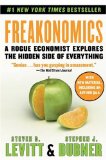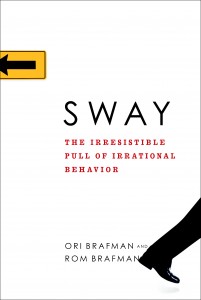I loved the original Freakonomics book and was excited when I first saw that Levitt and Dubner had released SuperFreakonomics. I received it as a late Christmas gift and tore through it in a couple of days. From a high level, I’d say if you liked the first book, and are willing to read more of the same, you’ll like this one.
I used to have very romantic ideas about academia. I imagined faculty were the intellectual elite who congregated to expand human knowledge, investigate the meaning behind everything and set aside the pretty bickering of lesser minds. While very smart people tend to be around universities, often the research is incredibly derivative, following academic fashion closer than a supermodel follows clothing fashion. Politics and petty bickering seems to be the focus of a pretty large portion of many academics’ time as well. The two Freakonomics books follow this spirit of intellectual inquiry I’d hoped to find at universities: the authors are smart, follow exciting work in economics, tie in current research to the human condition and challenges facing the human race and are able to politely and smoothly demolish objections made against the findings they present.
To order this book:
From the United States then please use this link for Amazon.com
If you are from Canada then please use this link for Amazon.ca
In the first book they indirectly took a shot at Malcolm Gladwell when they ripped apart the “broken window” explanation Gladwell presents in The Tipping Point to explain crime reduction in New York city. Gladwell offered what I found to be a somewhat lame counter-argument. In this book they take a couple more shots at Gladwell. They basically cast Outliers as one of three works based entirely on K . Anders Ericsson’s research (which is a fair criticism I’ve come across elsewhere). They also present a novel (to me anyway) perspective on the Kitty Genovese murder which was an important part the The Tipping Point. They touch on Atul Gawande’s “Better” and seem to have more respect for it than they do for Gladwell’s work.
One of my friends had said he “hated” SuperFreakonomics, and after reading it I asked him why. His feeling was that the examination of the economics of prostitution was too similar to the examination of crack deals in the first book. It was fair that they’re both detailed overview of the business behind illicit activities (and are based on work by the same economist), but I found them both fascinating. His other complaint was that it was “too much of the same” as the first book, which is valid. I view this as a positive, not a negative, myself. His third criticism was that one big part of the book was how to catch terrorists using data mining, and they left out the final punchline in “the interests of national security”. I agreed this was kind of anti-climatic (and they perhaps should have left this section out if they couldn’t provide all the details).
In the first book they rip into Realtors (showing pretty convincingly that most Realtors aren’t working as hard to get top dollar for properties as they claim to be). In this book they ask who adds more value: a pimp or a Realtor? They compared houses sold by the owners (paying a $500 flat rate) to those sold using a Realtor (charging 5% of the sale price, $20,000 for a $400K house). While they acknowledge possible confounds in the research, the findings were that houses sold for the same price with or without a Realtor. The big difference was that they sold 20 days sooner if the Realtor was involved (and question how many people are willing to pay $20K to not live in their house for an extra 20 days?). Pimps, in contrast, AFTER taking their 25% commission left prostitutes with a $85 HIGHER weekly salary than if they were working solo, and they slept with 1.6 LESS men each week. Additionally, prostitutes without pimps were more likely to be beat up or forced to give “freebies” to gang members and police officers.
Other topics in the book include: why current thinking on global warming isn’t productive, who terrorist are (rather than desperate, grubby people, they paint a picture of them as “super patriots”), how the introduction of television has helped women in India, an investigation into altruism (and how economic research supporting it was debunked), the (in)effectiveness of child car seats (for children above the age of 2), and whether its safer for a drunk to walk home or drive home.
Their book is well cited throughout, with footnotes directing interested readers to the original research studies this work is based on. It may just be that I’ve read too many of this type of book, but I was already familiar with a number of the research projects they detailed (which somewhat stole the surprise of the “twist”). If someone hasn’t read the first Freakonomics book I’d recommend reading it first, but SuperFreakonomics is just about as good.
To order this book:
From the United States then please use this link for Amazon.com
If you are from Canada then please use this link for Amazon.ca

 “Sway” by the brothers Ori and Rom Brafman is about “the irresistible pull of irrational behavior”. It was passed along to me after a friend enjoyed it and thought I would as well (which I did). It’s a fast, easy read in the style of a
“Sway” by the brothers Ori and Rom Brafman is about “the irresistible pull of irrational behavior”. It was passed along to me after a friend enjoyed it and thought I would as well (which I did). It’s a fast, easy read in the style of a